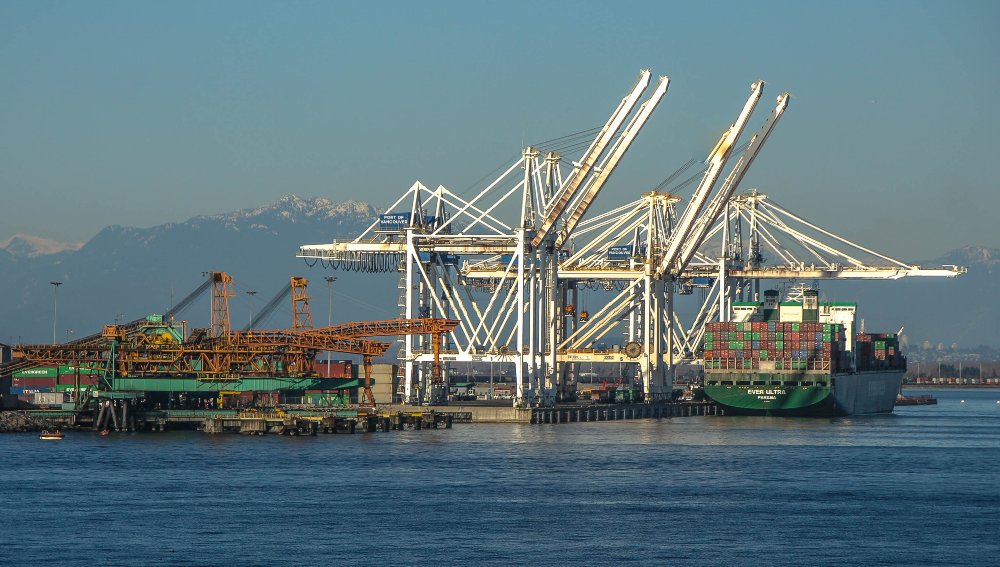This story first appeared in Salish Current, a Bellingham-based news service.
In 1984 I first became aware of the port on Roberts Bank in the south arm of the Fraser estuary, when we moved to a small farm in East Ladner. Back then it was only a coal port (what is now Westshore Terminal opened in 1970) with trains moving coal from mines in B.C. and the U.S. for shipping to Asia, out along a 2 kilometre causeway, jutting out into the Fraser estuary, to the terminal on Roberts Bank.
Then in 1997 the two-berth Deltaport container terminal opened, adding more trains moving export and import shipping containers to and from the port.
The only road in and out from our farm was via the grade crossing over the B.C. Rail Line out to the port. Very often those trains, moving slowly or stopped altogether on the rail track, blocked our access for 10 minutes or more several times a day.
That started my journey into understanding the many negative consequences of building a port right in the heart of one of the richest wildlife ecosystems in the whole of Canada. What started as a single man-made pod in the estuary is now a massive port complex with both coal and three-berth container terminals and many trains daily.
Now federal and B.C. provincial governments have approved a massive expansion of the port complex, adding a 177-hectare man-made island for the Roberts Bank Terminal 2 (RBT2) project.
What were they thinking approving an industrial port complex on Roberts Bank, a major stop on the Pacific Flyway for migratory and other shorebirds, also recognized as wintering grounds for the highest number of shorebirds anywhere in Canada?
In approving RBT2 (Roberts Bank Terminal 2) these two governments:

- Ignored the science and concerns from their own government scientists.
- Understated the negative impacts on intertidal biofilm rich in polyunsaturated fatty acids, critical for many wildlife species.
- Ignored the warnings of potential migratory bird population declines.
- Failed to understand significant adverse environmental effects leading to further declines in already endangered Southern Resident killer whales, potentially towards extinction.
- Ignored the man-made island’s negative impacts on crabs and juvenile salmon.
- Ignored the negative impacts to First Nations cultural and fishing practises.
- Approved re-creating biofilm as mitigation despite government scientists proving it is impossible to re-create biofilm on the scale necessary to replace what will be lost.
- Misread, or ignored altogether, weaknesses in the overall container trade picture and its future growth on the Canadian West Coast.
- Failed to recognize RBT2’s cost — estimated at $3.5 billion but likely to increase to between $4–6 billion — making it the most expensive greenfield port development anywhere in the world and economically unsustainable.
- Refused to acknowledge more sustainable, less environmentally damaging, less expensive alternatives capable of delivering the additional container terminal capacity within the same time frame as RBT2.
A Cascading Impact
Canadian government scientists portray RBT2’s adverse environmental effects on intertidal biofilm as immediate, permanent, continuous, irreversible and unable to be mitigated. Approving RBT2 results in the upset of the natural chemistry over Roberts Bank and destroys the quality of its unique intertidal biofilm.
These consequences, result in a cascading failure of the estuarine ecosystem, up to and including commercial crab and salmon species, eulachon, already endangered southern resident killer whales, as well as migratory and other shorebirds.

This catastrophe has all along been the major concern for government and other scientists.
Moreover, the Port of Vancouver is pushing ahead with RBT2 despite declining container volumes. Total container traffic was down by more than 3% in 2022 versus 2021. Worse yet, 2022 full-container loads were down by 9% compared to 2021.
In fact the Port handled fewer loaded containers in 2022 than in every year back to 2013. That dismal picture continues in 2023. Total container volumes for January to September 2023 are off by over 17%, with full import containers falling by 19% compared to the same period in 2022.
Major shipping lines are laying off staff and forecasting significant drops in container volumes. Vancouver is losing U.S. container traffic (as much as 25% of its total volumes). More and more U.S. containers are going by the all-water route direct to U.S. Gulf and East Coast ports, because it is cheaper and faster for shipping companies to get their goods to market. This is a fundamental and permanent change.
Better expansion alternatives: The Deltaport Berth 4 and Prince Rupert container terminal expansions can deliver much more terminal capacity than RBT2 within the same time frame, privately funded, at less cost and without the significant adverse environmental effects.
Discover more from Post Alley
Subscribe to get the latest posts sent to your email.

Interesting observations. The Seattle and Tacoma ports to the south are also battling declining container volumes as they complete less ambitious expansion plans. I wonder about the Canadian ports’ long-term strategy if the trans-Pacific market continues to shrink–is it to grow only at the expense of Seattle and Tacoma? Also, manufacturing capacity is moving south to Vietnam and other South Asian locations, making north Pacific ports less attractive.
I would also add a caveat about the competition from the Panama Canal route to the East Coast. Serious water shortages in the Canal now make it unreliable. The main Canadian advantage is that the railroads to the east are government owned and therefore well maintained, while the American rail lines, privately owned, are decaying.